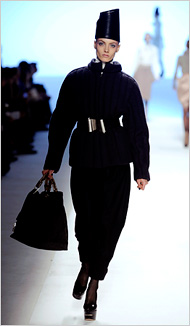^^got to disagree on that last statement... of course SOME women's dream would be to wear something "ethereal"... but even if they had the money for it, do you really think they'd do it? after all it's just a DREAM. after they fulfill their lifetime fantasy of wearing princess dresses, do you really think they'd want to stay the rest of their lives wearing the corsets, the frou-frou, the pink and lace, and so on?
people say they want what they cant have... if they cant afford it, theyll sure tell you how fantastic it would be to have all the money in the world to wear wonderful night-gowns all day long.
it doesnt make sense at all, but how would you prove they wouldnt do it, you sure arent gonna give them the money to see what they do, right?
with or without the money, it's the perception of the clients that has changed. there's hundreds of oil tycoon wifes, and rich socialites that could wear the most wonderfully crafted dresses for their everyday life. believe me, if they dont, it's really because they dont want to.
(latest finantial analysis are pointing to what is called the new "decade of jewellery". i've read it in economic papers, and jsut a couple of days ago i watched an interview with Boucheron CEOs who strongly reinforced the idea.
Their arguments to support this idea is that with economic recession coming and going and how uncertain the situation is, rich people would rather invest on diamonds and emerald necklaces that, if taken to pieces, would never loose their value as a dress could. Besides that, what the french call haute joaillerie doesnt need three fittings as a dress would, and the traveling of the collections from one country to another is a lot lot easier. After all, a LBD can be so easily reproduced these days, that if feels almost natural that people try to spend the money on something a lot more exclusive, and a lot harder to copy... the RTW everyone can have, but the rubies, not so many ))
EDIT: whoever says that all we care about TODAY is the money is being blindly unaware of the fact that MONEY HAS ALWAYS BEEN THE MATTER! do you really think Velazquez would have painted one single canvas if it wasnt to be part of the royal court? think of warhol (the materialist), dali (the greatest publicist), it just goes on, and on, and on... far back to egyptian architects that were greatly paid, if they did a good job with palaces, statues, and whatsoever!
people say they want what they cant have... if they cant afford it, theyll sure tell you how fantastic it would be to have all the money in the world to wear wonderful night-gowns all day long.
it doesnt make sense at all, but how would you prove they wouldnt do it, you sure arent gonna give them the money to see what they do, right?

with or without the money, it's the perception of the clients that has changed. there's hundreds of oil tycoon wifes, and rich socialites that could wear the most wonderfully crafted dresses for their everyday life. believe me, if they dont, it's really because they dont want to.
(latest finantial analysis are pointing to what is called the new "decade of jewellery". i've read it in economic papers, and jsut a couple of days ago i watched an interview with Boucheron CEOs who strongly reinforced the idea.
Their arguments to support this idea is that with economic recession coming and going and how uncertain the situation is, rich people would rather invest on diamonds and emerald necklaces that, if taken to pieces, would never loose their value as a dress could. Besides that, what the french call haute joaillerie doesnt need three fittings as a dress would, and the traveling of the collections from one country to another is a lot lot easier. After all, a LBD can be so easily reproduced these days, that if feels almost natural that people try to spend the money on something a lot more exclusive, and a lot harder to copy... the RTW everyone can have, but the rubies, not so many ))
EDIT: whoever says that all we care about TODAY is the money is being blindly unaware of the fact that MONEY HAS ALWAYS BEEN THE MATTER! do you really think Velazquez would have painted one single canvas if it wasnt to be part of the royal court? think of warhol (the materialist), dali (the greatest publicist), it just goes on, and on, and on... far back to egyptian architects that were greatly paid, if they did a good job with palaces, statues, and whatsoever!
Last edited by a moderator:




